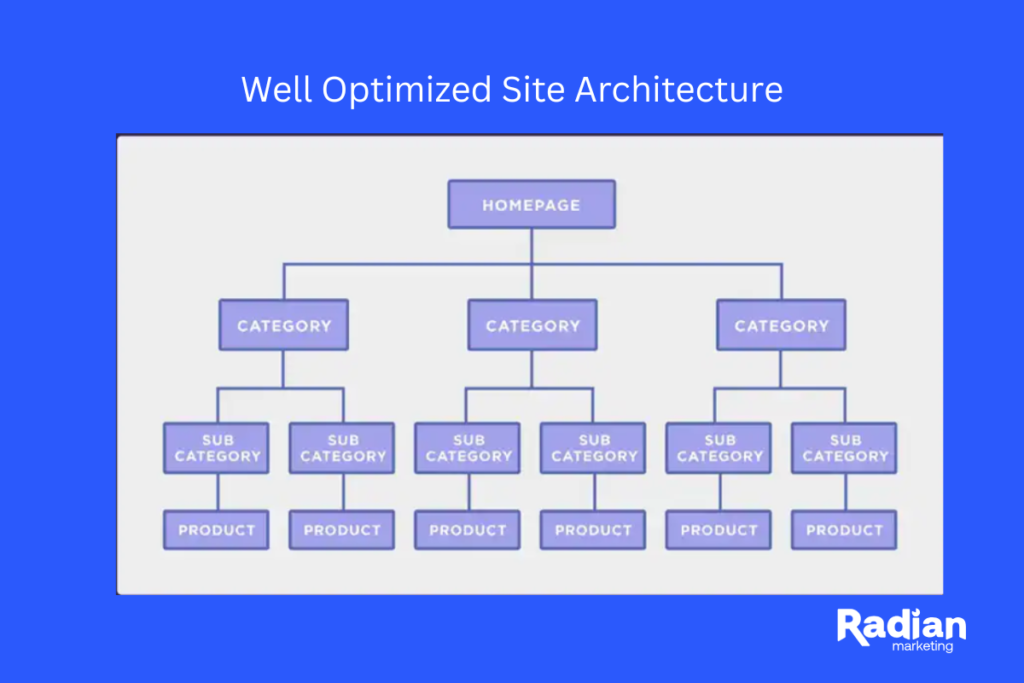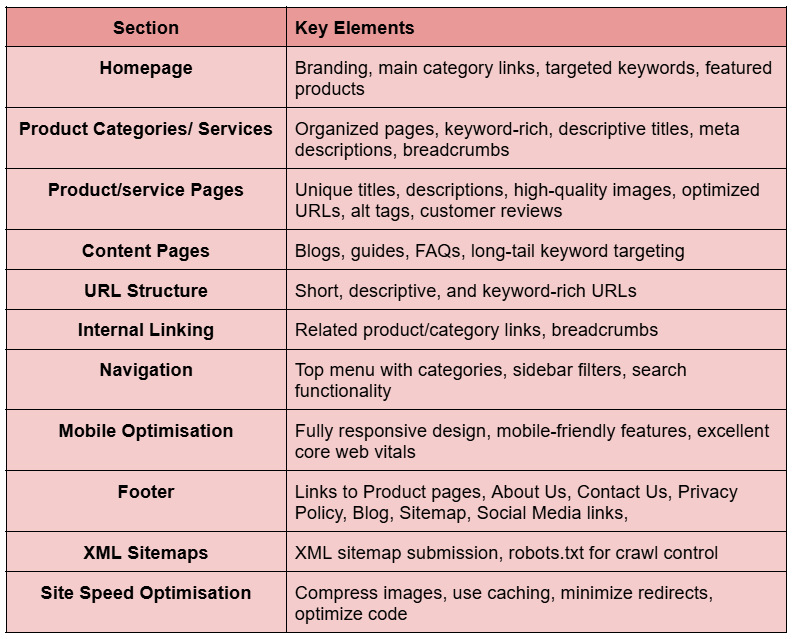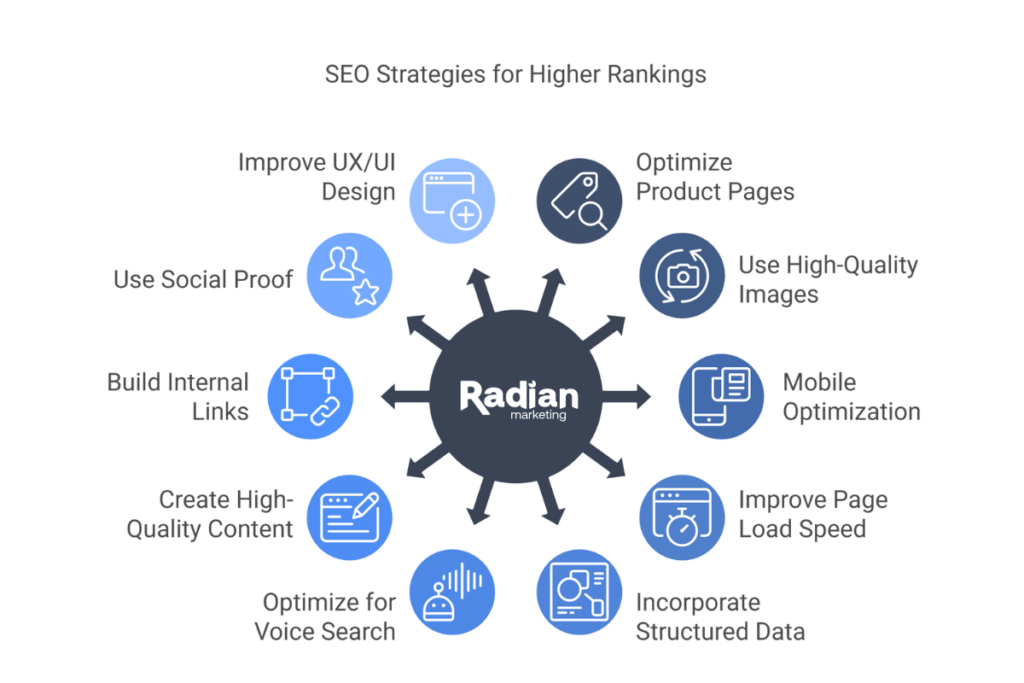How To Do SEO for Ecommerce Websites?
Wondering how to do SEO for an ecommerce website? It’s simpler than you think!
Ecommerce SEO helps your online store appear at the top of search engine results, driving more traffic and sales. Let’s explore how to do ecommerce SEO and make your website more visible to potential customers.
What is Ecommerce SEO?
In simple terms, Ecommerce SEO is the process of optimizing an online store to rank higher on search engines and attract more organic traffic. It involves various techniques such as keyword optimization, creating valuable content, and improving site structure.
When you know how to do SEO for Ecommerce website, you can enhance your product pages and blog content to rank better. SEO in ecommerce ensures that your website is easy for both search engines and users to navigate.
What Makes an Ecommerce Platform SEO Optimised?
For an ecommerce platform to be SEO optimized, it must support key SEO practices that help your website rank higher. This includes a clean URL structure, fast loading times, and mobile optimization.
A well-optimized ecommerce platform should support features like unique product pages, optimized metadata, and seamless integration with SEO tools and analytics to boost visibility.
For example: If you have a men’s clothing website, organizing your products into clear categories can enhance the customer experience by making it easier to find what they’re looking for.
As you can see in the following image, this Apparel Ecommerce website has categorised their products in four categories: Suits, Blazers, Jodhpuri Suits and Tuxedos.

Key Benefits of SEO For Ecommerce Websites
SEO plays a vital role in the success of ecommerce websites. You can improve visibility to increase sales by optimising websites. Here are the key benefits of implementing SEO for ecommerce:
- Increased Organic Traffic : Your ecommerce site attracts more visitors without relying on paid ads.
- Higher Conversion Rates: SEO-optimized product pages lead to better user experience and result in higher conversions.
- Cost-Effective Marketing: Unlike paid campaigns, SEO provides long-term benefits and sustainable traffic growth at a lower cost.
- Better User Experience: SEO helps improve website speed, navigation, and mobile optimization to create a seamless shopping experience for users.
- Builds Brand Credibility: Ranking on the first page of Google search results enhances your brand’s credibility among potential customers.
- Improved Local SEO: Local SEO helps you target customers in specific regions. It boosts foot traffic and sales for location-based ecommerce businesses.
How To Structure an Ecommerce Website For SEO
Structuring your ecommerce website correctly is essential for both search engine optimization and user experience. A well-organized site not only helps search engines crawl and index your pages effectively but also ensures a smooth and seamless shopping experience for your customers.
Knowing how to structure an ecommerce site for SEO can improve your site’s visibility on search engine results pages (SERPs), attract more organic traffic, and drive higher conversions.

Like we implemented a clean, SEO-optimized structure for The UrbanClad, helping improve category discoverability and enhance user navigation across suits, blazers, and tuxedos.This helped them acquire new customers within just three months
Here is an example of an ideal SEO Optimised website:
Ideal Structure for an SEO Optimised Website
Below screenshot tells you how to categorize products in your ecommerce website.

We’ve curated following table to help you understand what structure your Ecommerce website should include. Do save it if you’re still in the website building phase.

Top 10 Strategies To Rank Higher On SERPs
Here are the Top 10 Strategies to Rank Higher on SERPs for your ecommerce website:

1. Optimize Product Pages: Make sure each product page is optimized and contains high-quality, keyword-rich titles, descriptions, and images. Focus on customer intent and include important details like product features, benefits, and specifications.
Example: If you own a UK-based skincare ecommerce business, optimize your product page for a popular item like Vitamin C Serum with a title such as “Vitamin C Serum for Glowing Skin – Made in the UK”. Use high-quality images, and write a keyword-rich description that highlights key benefits like skin brightening and anti-aging. Include detailed specifications, ingredients, usage tips, and skin type compatibility to align with customer intent and boost visibility in search results.
2. Use High-Quality, Optimized Images: Compress and properly label images with descriptive, keyword-rich alt tags. This helps with both SEO and user experience, especially for image-based searches.
3. Mobile Optimization: Ensure your website is fully responsive, as Google prioritizes mobile-friendly websites in rankings. Test your site’s mobile experience and make adjustments to improve speed and usability.
4. Improve Page Load Speed: Use tools like Google PageSpeed Insights to analyze and optimize your site speed. Compress images, leverage browser caching, and minimize HTTP requests to ensure fast page loading times.
5. Incorporate Structured Data (Schema Markup): Add schema markup to your product pages to display rich snippets such as price, availability, and reviews in search results, increasing visibility and click-through rates.
6. Optimize for Voice Search: With the rise of voice search, it’s crucial to optimize for conversational queries. Focus on long-tail keywords and natural language that people might speak into voice search devices.
For Example:
If you run an electronics eCommerce store in Los Angeles, USA optimize for voice queries like “What’s the best budget gaming laptop under $50,000 in Los Angeles” or “Where can I buy noise-cancelling headphones online?” Instead of just targeting short keywords like “gaming laptop,” use conversational, long-tail phrases that reflect how customers naturally speak when using voice assistants like Alexa or Google Assistant.

7. Create High-Quality Content: Develop engaging, informative content like blogs, buying guides, and FAQs to target long-tail keywords. This boosts organic traffic and establishes your site as an authority in your niche.
8. Build Internal Links: Interlink related product pages, categories, and content to guide both users and search engines through your site. This not only improves crawlability but also distributes link equity across your site.
9. Use Social Proof and Customer Reviews: Incorporate customer reviews, ratings, and testimonials on product pages. Positive reviews enhance user trust and engagement, while also improving SEO by providing fresh, user-generated content.
For example: If you run a beauty product ecommerce site, showcase customer reviews on product pages like a 4.8-star rating and reviews for your best selling hydrating face moisturizer or any product you sell. Highlight real testimonials mentioning visible results, skin type compatibility, and repeat purchases. This helps to build trust with new shoppers and adds fresh, keyword-rich content that boosts SEO.
10. Improve UX/UI Design: A clean, user-friendly design with easy navigation and clear calls to action encourages visitors to stay longer on your site, reducing bounce rates and improving rankings. Optimize your site’s layout and design for better conversion rates.
Metrics To Track Success Of Ecommerce SEO
To track the success of your ecommerce SEO efforts, you should monitor various key performance metrics. Here are the top metrics to track:
- Organic Traffic: The volume of visitors coming from search engines is a clear indicator of how well your SEO strategy is performing. A steady increase in organic traffic means your site is gaining visibility in search results.
- Keyword Rankings: Track the rankings of your targeted keywords, especially those for your top products and categories. Improved rankings suggest that your SEO efforts are successfully optimizing for relevant search queries.
- Bounce Rate: This metric shows the percentage of visitors who leave your website after viewing only one page. A high bounce rate may indicate poor user experience or irrelevant content, while a low rate suggests engagement.
- Conversion Rate: The percentage of visitors who make a purchase after landing on your website. Improving your ecommerce SEO should ideally lead to higher conversion rates, as more qualified traffic is directed to your site.
- Average Session Duration: The amount of time users spend on your site. A higher average session duration typically reflects valuable content and a positive user experience. Both of which can indirectly boost SEO rankings.
- Pages Per Session: This shows how many pages a user views during one session. Higher pages per session indicate that users find your website engaging and navigate to multiple pages, suggesting better user experience and content relevance.
- Organic Search Revenue: Track how much revenue is generated from organic search traffic. This directly measures the impact of your SEO efforts on your ecommerce sales and helps assess ROI.
- Backlink Profile: Monitor the number and quality of backlinks pointing to your ecommerce site. High-quality backlinks from authoritative websites can improve your domain authority and SERP rankings.
- Click-Through Rate (CTR): The percentage of users who click on your website from search engine results. A higher CTR means your titles and meta descriptions are compelling and relevant to searchers.
- Indexed Pages: The number of pages on your site that have been indexed by search engines. More indexed pages usually mean better coverage of your content and products, helping to attract more search traffic.
How To Improve Ecommerce SEO?
Improving ecommerce SEO is essential for driving more traffic and boosting sales. To improve ecommerce SEO effectively, following steps should be kept in mind :
- Optimize product pages with relevant keywords, high-quality images, and detailed descriptions.
- Improve site speed to reduce bounce rates and boost rankings.
- Ensure mobile optimization for a seamless user experience across devices.
- Add structured data (schema markup) to display rich snippets in search results.
- Create high-quality content like blogs, buyer’s guides, and FAQs for organic traffic.
- Use SEO-friendly URLs that are clean, descriptive, and keyword-rich.
- Implement local SEO with location-based keywords and a Google My Business profile.
- For businesses offering fast delivery services, using quick commerce marketing boosts sales by targeting urgent searches and local demand on such platforms like Zepto, BlinkIt if your business is in India.
- Enhance user experience with easy navigation and clear calls-to-action.
By following the above steps, you can effectively learn how to improve SEO of an ecommerce website and drive more organic traffic and sales
For example: If your ecommerce store is based in India, optimizing for local SEO is a game-changer. For instance, a fashion brand in Mumbai can rank higher by targeting keywords like “best men’s suits in Mumbai” and integrating Google My Business with positive local reviews.

In a Nutshell
Effective ecommerce SEO is a powerful tool for increasing your website’s visibility, driving organic traffic, and boosting conversions. By optimizing your site structure, product pages, and content, and tracking the right metrics, you can create an SEO-friendly ecommerce site that ranks higher on search engines. To maximize results, it’s also essential to integrate strategies like social media community management, which can boost brand engagement, build trust, and support your SEO efforts.
Whether you’re just starting with SEO or enhancing your current strategy, using the right techniques consistently will help your ecommerce site succeed in any competitive market. We’re a leading Ecommerce Agency with experience growing businesses across the world, get in touch for an expert consultation.



Bhaskar Gupta
Bhaskar Gupta is a passionate digital marketing practitioner and has keen interest in SEO, Social Media Strategy, Business Digital growth, and Performance marketing. He has worked with multiple brands in different industries across India and abroad. In 2022, he has set up his own digital growth and marketing agency named Radian Marketing.